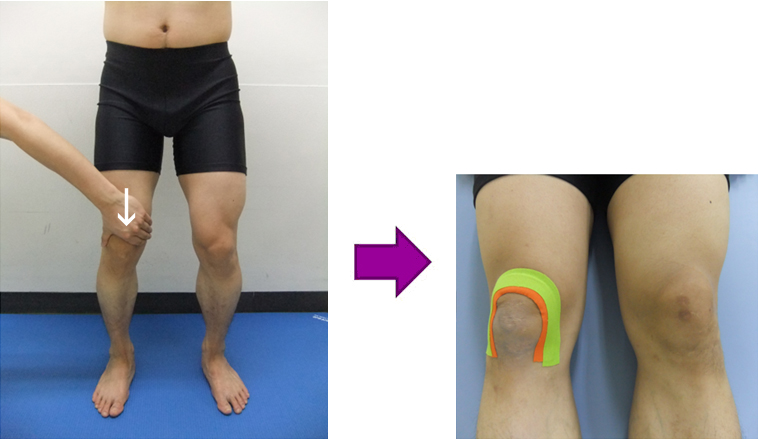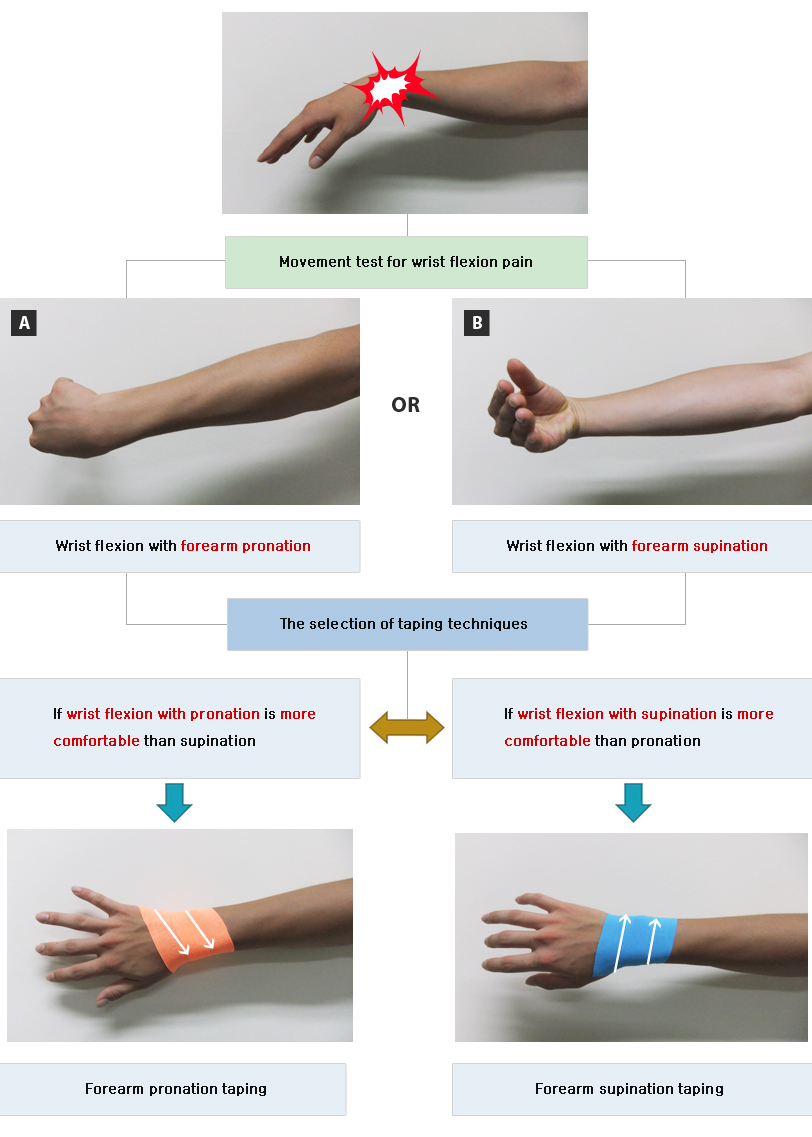Differences from the Conventional Taping Method
1. In the case of severe pain, a stretched posture prior to tape application is not always required1)
Placing the patient into a pre-stretched posture before tape application is traditionally used to create skin convolutions for circulation space, but is not necessary. Putting the patient into a stretched posture worsens existing pain. In back pain patients, trunk flexion is difficult and causes more pain.2) A recent study stated that tape applied with tension to generate convolutions in the stretched skin was no more effective than application of the tape without tension.3) Subjects should be comfortable while Balance Taping is performed. Application of a longer, more stretched piece of tape is appropriate when stretching causes pain for the patient. However, if a more stretched tape is to patients who are unable to stretch, there should be greater attention paid to avoid skin problems. The tape must be removed immediately if there is itching, to avoid discontinuation of treatment due to an adverse reaction to the tape (remove the kinesiology tape immediately if there is dizziness or itching regardless of the application time).
2. Maximum duration of application is one day.4, 5, 6) Do not apply for longer than one day, even if there is no itching.1)
Reason1)
(1) Skin problems (allergic contact dermatitis).
(2) Testing should be performed prior to Balance Taping due to change in the status of the subject (i.e., the status of the patient can change every day and Balance Taping method differs according to the status of the patient).
(3) Adaptation to skin stimulation by kinesiology tape can occur. Therefore, new skin stimulation is required.
(4) Sweating occurs in everyday life and sports activities, and can cause skin problems or pain.
3. The use of the movement or contact test1)
An accurate and simple assessment should be performed before Balance Taping. The causes of pain and muscular or joint dysfunction are diverse; thus, contact and movement tests are used to confirm the precise areas to target before Balance Taping. As taping provides stimulation via the skin, before applying the Balance Taping, the pain and movement responses are first verified by stimulation of the targeted area with the palm of the hand. If pain relief and improved movement are observed in the contact test, Balance Taping is applied to stimulate the muscles in contact with the tape. If pain relief and improved movement are observed in the movement test, Balance Taping is applied to maintain the joint orientation that aids movement. Contact test: Test to confirm if movement is comfortable (i.e., pain reduction and increased movement) by touching with the palm (i.e., a method to activate the gamma motor reflex through skin stimulation; the muscle should respond with mild physiologic contraction) or application of manual mechanical pressure before Balance Taping. Touch or manually press the patient's body to assess the reaction and the degree of pain relief.
Example 1: Dysfunction of inferior patellar gliding on the patellofemoral joint1)
Contact test for patellar inferior gliding: test to confirm reduction in knee flexion pain or increase in knee flexion (contact area: above the patella). Press the patella downward.1)
Movement test: test to confirm reduction in pain or increase in range of motion of the affected joint in rotation.
Example 1: Movement Test for Professional Balance Taping of the Wrist1)
Movement test for wrist flexion pain: test to confirm reduction in wrist flexion pain or increase in wrist flexion with forearm pronation (Figure A) or supination (Figure B).1)

1. In the case of severe pain, a stretched posture prior to tape application is not always required1)
Placing the patient into a pre-stretched posture before tape application is traditionally used to create skin convolutions for circulation space, but is not necessary. Putting the patient into a stretched posture worsens existing pain. In back pain patients, trunk flexion is difficult and causes more pain.2) A recent study stated that tape applied with tension to generate convolutions in the stretched skin was no more effective than application of the tape without tension.3) Subjects should be comfortable while Balance Taping is performed. Application of a longer, more stretched piece of tape is appropriate when stretching causes pain for the patient. However, if a more stretched tape is to patients who are unable to stretch, there should be greater attention paid to avoid skin problems. The tape must be removed immediately if there is itching, to avoid discontinuation of treatment due to an adverse reaction to the tape (remove the kinesiology tape immediately if there is dizziness or itching regardless of the application time).
2. Maximum duration of application is one day.4, 5, 6) Do not apply for longer than one day, even if there is no itching.1)
Reason1)
(1) Skin problems (allergic contact dermatitis).
(2) Testing should be performed prior to Balance Taping due to change in the status of the subject (i.e., the status of the patient can change every day and Balance Taping method differs according to the status of the patient).
(3) Adaptation to skin stimulation by kinesiology tape can occur. Therefore, new skin stimulation is required.
(4) Sweating occurs in everyday life and sports activities, and can cause skin problems or pain.
3. The use of the movement or contact test1)
An accurate and simple assessment should be performed before Balance Taping. The causes of pain and muscular or joint dysfunction are diverse; thus, contact and movement tests are used to confirm the precise areas to target before Balance Taping. As taping provides stimulation via the skin, before applying the Balance Taping, the pain and movement responses are first verified by stimulation of the targeted area with the palm of the hand. If pain relief and improved movement are observed in the contact test, Balance Taping is applied to stimulate the muscles in contact with the tape. If pain relief and improved movement are observed in the movement test, Balance Taping is applied to maintain the joint orientation that aids movement. Contact test: Test to confirm if movement is comfortable (i.e., pain reduction and increased movement) by touching with the palm (i.e., a method to activate the gamma motor reflex through skin stimulation; the muscle should respond with mild physiologic contraction) or application of manual mechanical pressure before Balance Taping. Touch or manually press the patient's body to assess the reaction and the degree of pain relief.
Example 1: Dysfunction of inferior patellar gliding on the patellofemoral joint1)
Contact test for patellar inferior gliding: test to confirm reduction in knee flexion pain or increase in knee flexion (contact area: above the patella). Press the patella downward.1)

Movement test: test to confirm reduction in pain or increase in range of motion of the affected joint in rotation.
Example 1: Movement Test for Professional Balance Taping of the Wrist1)
Movement test for wrist flexion pain: test to confirm reduction in wrist flexion pain or increase in wrist flexion with forearm pronation (Figure A) or supination (Figure B).1)

1) Lee JH, Choi SW. Balace Taping: Clinical Application of Elastic Therapeutic Tape for Musculoskeletal Disorders. Paju: WE TAPE. 2016.
2) Lee JH, Yoo WG. Application of posterior pelvic tilt taping for the treatment of chronic low back pain with sacroiliac joint dysfunction and increased sacral horizontal angle.
Phys Ther Sport. 2012;13:279-285.
3) Parreira, Patricia do Carmo Silva, et al. Kinesio taping to generate skin convolutions is not better than sham taping for people with chronic non-specific low back pain: a randomised trial.
J Physiother. 2014;60:90-96.
4) Hwang-Bo G, Lee JH. Effects of kinesio taping in a physical therapist with acute low back pain due to patient handling: a case report. Int J Occup Med and Environ Health.
2011;24:320-323.
5) Kim BJ, Lee JH. Effects of scapula-upward-taping using kinesiology tape in a patient with shoulder pain caused by scapular downward rotation. J Phys Ther Sci. 2015;27:547-548.
6) Lee SM, Lee JH. Ankle inversion taping using kinesiology tape for treating medial ankle sprain in an amateur soccer player. J Phys Ther Sci. 2015;27:2407-2408.
2) Lee JH, Yoo WG. Application of posterior pelvic tilt taping for the treatment of chronic low back pain with sacroiliac joint dysfunction and increased sacral horizontal angle.
Phys Ther Sport. 2012;13:279-285.
3) Parreira, Patricia do Carmo Silva, et al. Kinesio taping to generate skin convolutions is not better than sham taping for people with chronic non-specific low back pain: a randomised trial.
J Physiother. 2014;60:90-96.
4) Hwang-Bo G, Lee JH. Effects of kinesio taping in a physical therapist with acute low back pain due to patient handling: a case report. Int J Occup Med and Environ Health.
2011;24:320-323.
5) Kim BJ, Lee JH. Effects of scapula-upward-taping using kinesiology tape in a patient with shoulder pain caused by scapular downward rotation. J Phys Ther Sci. 2015;27:547-548.
6) Lee SM, Lee JH. Ankle inversion taping using kinesiology tape for treating medial ankle sprain in an amateur soccer player. J Phys Ther Sci. 2015;27:2407-2408.


